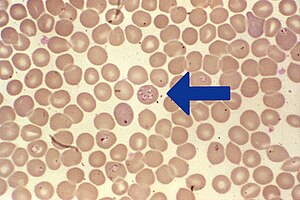Babesiosis
| Babesiosis | |
|---|---|
 |
|
| Classification and external resources | |
| Specialty | Infectious disease |
| ICD-10 | B60.0 |
| ICD-9-CM | 088.82 |
| DiseasesDB | 1200 |
| Patient UK | Babesiosis |
| MeSH | D001404 |
| Orphanet | 108 |
Babesiosis is a malaria-like parasitic disease caused by infection with Babesia, a genus of Apicomplexa. Human babesiosis is an uncommon but emerging disease in the Northeastern and Midwestern United States and parts of Europe, and sporadic throughout the rest of the world. It occurs in warm weather. Ticks transmit the human strain of babesiosis, so it often presents with other tick-borne illnesses such as Lyme disease. After trypanosomes, Babesia is thought to be the second-most common blood parasite of mammals, and they can have a major impact on health of domestic animals in areas without severe winters. In cattle, a major host, the disease is known as Texas cattle fever, redwater, or piroplasmosis.
Babesia species are in the phylum Apicomplexa, which also has the protozoan parasites that cause malaria, toxoplasmosis, and cryptosporidiosis. Four clades of Babesia species infect humans. The main species in each clade are:
Half of all children and a quarter of previously healthy adults are asymptomatic with Babesia infection. When people do develop symptoms, the most common are fever and hemolytic anemia, symptoms that are similar to those of malaria. People with symptoms usually become ill 1 to 4 weeks after the bite, or 1 to 9 weeks after transfusion of contaminated blood products. A person infected with babesiosis gradually develops malaise and fatigue, followed by a fever. Hemolytic anemia, in which red blood cells are destroyed and removed from the blood, also develops. Chills, sweats, and thrombocytopenia are also common symptoms. Symptoms may last from several days to several months.
Less common symptoms and physical exam findings of mild-to-moderate babesiosis:
In more severe cases, symptoms similar to malaria occur, with fevers up to 40.5°C (105°F), shaking chills, and severe anemia (hemolytic anemia). Organ failure may follow, including adult respiratory distress syndrome. Severe cases occur mostly in people who have had a splenectomy. Severe cases are also more likely to occur in the very young, very old, and persons with immunodeficiency, such as HIV/AIDS patients.
...
Wikipedia
